"We don't have to go to Machu Picchu now," Camille said at Ollantaytambo, on our first full day in Peru.
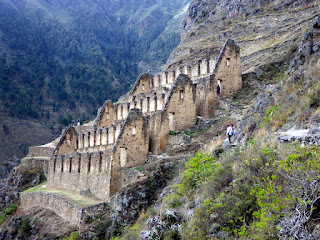 |
| Ollantaytambo |
 |
| At the Ollantaytambo ruins |
Ollanta--as the locals call it--was stunningly beautiful, as was the rest of the Sacred Valley, which we'd visit over the next few days as we acclimated to the altitude and awaited our lost luggage before starting the Inca Trail. There was beauty everywhere we looked. Just when I thought I was ruined out, the next set of ruins (and the surrounding countryside) blew my mind.
Before I go on, note the two travel lessons/tips implied above: always allow a few days for delayed arrival and lost luggage, if you have to check it at all (and when you're lugging trekking poles and a sleeping bag, there's no way around it), and don't skimp on the Sacred Valley in a race to Machu Picchu. Oh, and have enough stuff in your carry-on to get you through those first few days--clothes, sunblock, etc. There was a couple on our same set of flights--on the initial flight to Miami that was delayed (for administrative and then mechanical reasons) just enough for us to miss our connecting flight to Lima, and then on the flights to Bogoto and then Lima on which we (but not our luggage) were rerouted. They had a day or two before they headed to MP (mind you, they were taking the train), and we don't know whether they got their bags in time.
We were all lucky many times over to get to Cusco the same day we'd planned (if late in the evening, not first thing in the morning as planned). All of the airport staff, at every airport, was very helpful in getting us there. The best decision we made--another lesson--was to pay a little bit more to get our outgoing ticket all the way through to Cusco, rather than buying it separately, so they'd rebook us when we missed the original flight. Of course, we barely made the last flight from Lima to Cusco--while we were filling out our lost-luggage claims at the Avianca counter in Lima, we'd missed the check-in window for Cusco. But a kind LAN employee at the counter made some calls and told us to run, and we did. We got to security, where some dude was slowly working something out with the security guy about his laptop. We asked if we could go ahead; the dude's wife pointed to the space on the conveyer belt behind their bags, saying we could go ahead
there, but the annoyed security guy waved us through, and on we went. We were perfectly on time for the gate--or rather the bus for the gate--but they have rules about how soon you have to check in. Had we gotten stuck in Lima, nobody would have owed us a hotel (American had paid for ours in Miami the night of that first missed connection), and we would have lost even more time in transit. But enough about logistics; we made it, and we were grateful.
We got to Cusco late and luggageless, but we were greeted by a bowl of coca leaves in the arrivals area. I asked someone how much we should expect to pay for a cab into town, and she suggested we step outside the airport gate to pay half to a third of the price, so we did. Except that the cab driver started begging for more practically the minute he drove off with us, and took us by way of the Ganges to make a point.
If you're thinking, 'but he's so poor and you're not,' that is not relevant to the matter at hand. He's a cab driver, not a charity case, and cab rides aren't paid on a sliding scale. Furthermore--and especially--it's damaging to a local population for tourists to pay more for cabs, as drivers start to favor them at the expense of locals. As the begging and pleading continued, I realized I'd have to get change, as I'd never get back any of the 100 soles' bills ($30) I got out of the ATM. When the dude finally found our hotel, the very helpful receptionist did not have change for a hundred but did loan me a S20 (more than we'd agreed to pay, but little enough to get us out of a trap) for the driver.
The hotel staff continued to be incredibly helpful--calling after our luggage, getting us ice for Camille's swollen knees and hot water bottles for our tired legs, and generally looking out for us. It wasn't the highest-end of places, but the service was impeccable. In the reception room was a hot water dispenser and--you guessed it--a big bowl of coca leaves.
 |
| Chinchero market (vendor's daughter, taken with permission) |
I had no trouble at all with altitude (nor did Camille, but she'd taken altitude meds). Cusco is at just over 11,000 feet (11,152' if you must know) and a couple of spots in the Sacred Valley are higher (Chinchero is at 12,343').
The highest point on the Inca Trail, Dead Woman's Pass, is at 13,828'; I probably felt the altitude, but I can't tell you for sure because I was busy feeling just having climbed a gazillion steep steps.
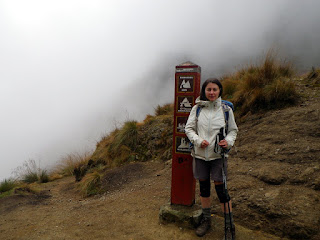 |
| Dead-Woman's Pass, where it's too cloudy to see anything |
I ended up hiking the four-day Inca Trail in three days, under disappointing circumstances that nonetheless worked out as best they could. A couple of days before the trek, Camille learned that her knee problems were worse than she'd known. She had trained for the trek through exercise, but not hiking, and our third day of hiking in the Sacred Valley--at the very steep Pisac ruins--hurt her knees badly.
 |
| Pisac |
 |
| Pisac, at a point after some particuarly steep steps |
The second and third days will kick your ass and your knees. Luckily for us, it was just the two of us in our group, so she was able
to complete the first day of the trek--she's a trooper--and come down to
Ollanta with one of the porters before the trail got real, from which she took the train to Aguas Calientes from
there, where we met up with her the third night to get the bus to MP the
next day.
The first
day (11km) isn't
easy, but it's not super-challenging. So it was just me and the guide after the first day (the porters/cooks run ahead and meet you at the lunch spots and campsites).

On the first day, the guide predicted from my pace that I'd complete the trail in three days. On the second day, we made it to where we would have camped that night, by lunchtime, and kept going through the hardest part of of the third day, to camp at Chakicocha. That left a beautiful, relatively leisurely actual third day (in which we also completed the short fourth day and got to the Sun Gate around 4:30).
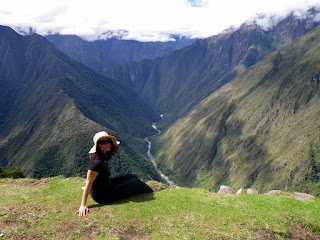 |
| Almost there |

I wasn't in pain until we walked from MP to Aguas Calientes--all downhill. My knees were feeling it at the end of the second day and again upon arrival in Aguas, which I suppose is understandable (knee braces were a goodsend, as were trekking poles).
I loved, loved the trail and sort-of missed it, but I didn't miss the cold (of the second campsite, which was below freezing) or the lack of plumbing.
I love camping, and I had a warm enough sleeping bag and enough layers to keep me warm outside of it, but the confluence of circumstances was such that I was ready to get inside.
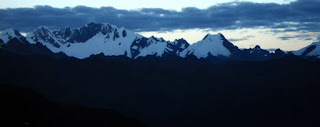 |
| Our campsite was at about the same level as these glaciers |
I found out later that the whole campsite was kept up that night by a group of drunk porters (I was too tired to be kept up, until I woke up in the middle of the night and heard something, but was kept up by other things anyway). Such as my stomach; nothing I ate in Peru--not a thing--agreed with me. This doesn't make for comfortable camping. Happy Cow failed me for the first time in my travels; the places it recommended were closed, either permanently or for renovation. I've not had so much crap--processed, sugary food; eggs and cheese; etc. in years. Some days the healthiest things I ate were the granola bars I brought. I don't love subsisting on granola bars, but it's better than changing plans because you're starving. The food on the trek was very good, but my dietary restriction got lost in the fine print. Before you start with 'why should they...' note that they advertize that they accommodate dietary restrictions, and they included mine on the contract. It's one thing to clearly state that there's one kind of food and you'll be eating it, and another to claim to accommodate dietary restrictions and not do so. Peruvian food is pretty plant-based as it is, so I was okay and I didn't want to get anyone in trouble, but it was, as I said, a lot of eggs and cheese. I couldn't wait to get back to being vegan.
The guide asked me what the issue was with eggs and cheese. I told him that in the United States, at least, those were generally the product of the factory farming system that destroys the planet and kills animals in the process of extracting their products--eg., kills the calfs to get the cow's milk and kills the male chicks that don't yield eggs. One reason--besides necessity--I had fewer issues with consuming eggs and dairy in Peru was that the chickens were free-roaming and calfs grew into the bulls that helped with the farming. He acknowledged my perspective, but insisted that I
needed animal products for nutrition. I pointed out that I'd just trekked the Inca Trail in three days, so did he have any reason to think I was lacking in nutrients?
 |
| Vegan ceviche |
 |
| Quinoa |
***
Our porters were not drunk; they were awesome. We (I) picked the trekking company in part based on the fact that they were indigenous-owned and managed, and treated their porters well. The night before the trek, we stayed in the village of the lead porter. We walked past fields of quinoa and barley to "help" him and his wife harvest potatoes; we had appetizers (roasted potatoes and lima beans) in an oven he made in the ground in the potato field (pachamanca, or earth oven), and then met them back at their place for dinner.
 |
| Senor Condor, tossing potatoes onto a blanket |
 |
| The pachamanka |

We got a head start, as they were faster in spite of also having to take their animals back. I wish I'd gotten a picture of all the helper animals--both along the walk, and chilling in their 'yard' as we left for the night--but it was getting dark by then. At their house, they served us dinner--the best quinoa soup ever, among other things. Guinea pigs scurried around the floor and fought over the beanpoles, and screeched. They sliced potatoes by hand in smaller, neater slices than I could ever make by machine or other tool. Someone else from the village came in to play harp, and we danced. When we stepped out, it was pitch black and the stars were intense and amazing--as they were throughout the trail. At the second night's camping spot, with a new moon, you can see the whole milky way. As it were, venus shone very brightly.
We stayed in a room with bunk beds, in a small complex owned by the owner of the trekking company, which gives back to the community. Their kitten made friends with me, and attacked my sleeping bag as I tried to roll it up. We had breakfast in the room where they built a school for the village. The farmers work non-stop (can you imagine farming, and moonlighting as a porter?), and there's no social safety net so they work their whole lives.
I often forget that I speak Spanish, and I didn't realize before the trip how much it would help--but it really helped. We would have gotten by without it, but we not only got by better, but enjoyed being able to talk to people because of it. I tried to learn a few words and phrases in Quechua--the language that the porters and guides spoke to each other--and came away with two: "ayiyanchi" (hello) and "sulpaki" (thank you), apart from place names. At one point, I repeated after our guide a prayer to mother earth, as I placed a stone as an offering at Runkuraqay (one of the ruins along the trail).
Our guide had a small tablet, which he used as a visual aid for explanation, and also for entertainment. The first night, he showed us a video of his son dancing at an event, and the second night he played music. He played "Sound of Silence" and asked me what 'neon' meant; he had actually looked up 'the neon god' but couldn't find anything. I explained 'neon' the gas and 'neon god' the metaphor, at least as I understood it and could best explain it, as a shallow, false idol.
***
To get around the Sacred Valley, we took collectivos--minibuses that leave when they fill up--and had no regrets about not paying a private driver.
 |
| Random alpacas along the road |
We did pay a driver at the turnoff for Maras (where the collectivo dropped us) to take us to Moray
 |
| Moray |
 |
| The salineras (yes, that is salt!) |
 |
| Salineras |
and the Salineras, and even then were horrified when he tried to impose a time limit on our exploring. And we decided to go on a bus tour of the Valle Sur, which was worth it--not least because I hardly saw a bus, collectivo, or cab in the area--but reinforced that we'd made the right decision in the other places. We had a small amount of time to explore in both Tipon and Pikillacta, but I was fast enough to make the most of it. At Pikillacta--where the ruins are Wari, i.e., pre-Inca--I walked to the far part of the ruins that none of the rest of the group ventured to, and it wasn't to be missed. I had to run back to the bus, but it was worth it.
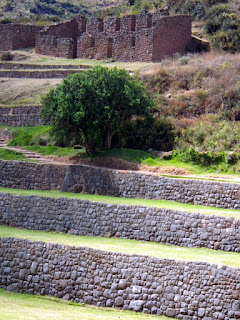 |
| Tipon |
 |
| Valle Sur (from Tipon) |
 |
| Tipon |
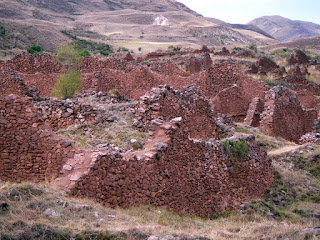 |
| Pikillacta |
The Inca, too, were conquistadores, our (Inca Trail) guide reminded us; other indigenous groups allied with the Spanish against them, which contributed to the quick collapse of the Inca empire just a couple of years after the Spanish arrived. I'm not sure that made me any less angry about its destruction; you can't walk around the Sacred Valley without wondering (rhetorically) who thought it was a good idea to destroy the Inca civilization. We're all lucky the Spanish never found Machu Picchu, or there would no longer be a Machu Picchu just as there is no longer a Vilcabamba.
 |
| Pikillacta |
We're very lucky, because look at Machu Picchu.
 |
| Can you see the Inca face? |
 |
| Machu Picchu from Huayna Picchu (that's right--I'm on the nose of the Inca face!) |
That's all for now; maybe more later.
 |
| Sacsayhuaman |
 On the first day, the guide predicted from my pace that I'd complete the trail in three days. On the second day, we made it to where we would have camped that night, by lunchtime, and kept going through the hardest part of of the third day, to camp at Chakicocha. That left a beautiful, relatively leisurely actual third day (in which we also completed the short fourth day and got to the Sun Gate around 4:30).
On the first day, the guide predicted from my pace that I'd complete the trail in three days. On the second day, we made it to where we would have camped that night, by lunchtime, and kept going through the hardest part of of the third day, to camp at Chakicocha. That left a beautiful, relatively leisurely actual third day (in which we also completed the short fourth day and got to the Sun Gate around 4:30). I wasn't in pain until we walked from MP to Aguas Calientes--all downhill. My knees were feeling it at the end of the second day and again upon arrival in Aguas, which I suppose is understandable (knee braces were a goodsend, as were trekking poles).
I wasn't in pain until we walked from MP to Aguas Calientes--all downhill. My knees were feeling it at the end of the second day and again upon arrival in Aguas, which I suppose is understandable (knee braces were a goodsend, as were trekking poles).

















